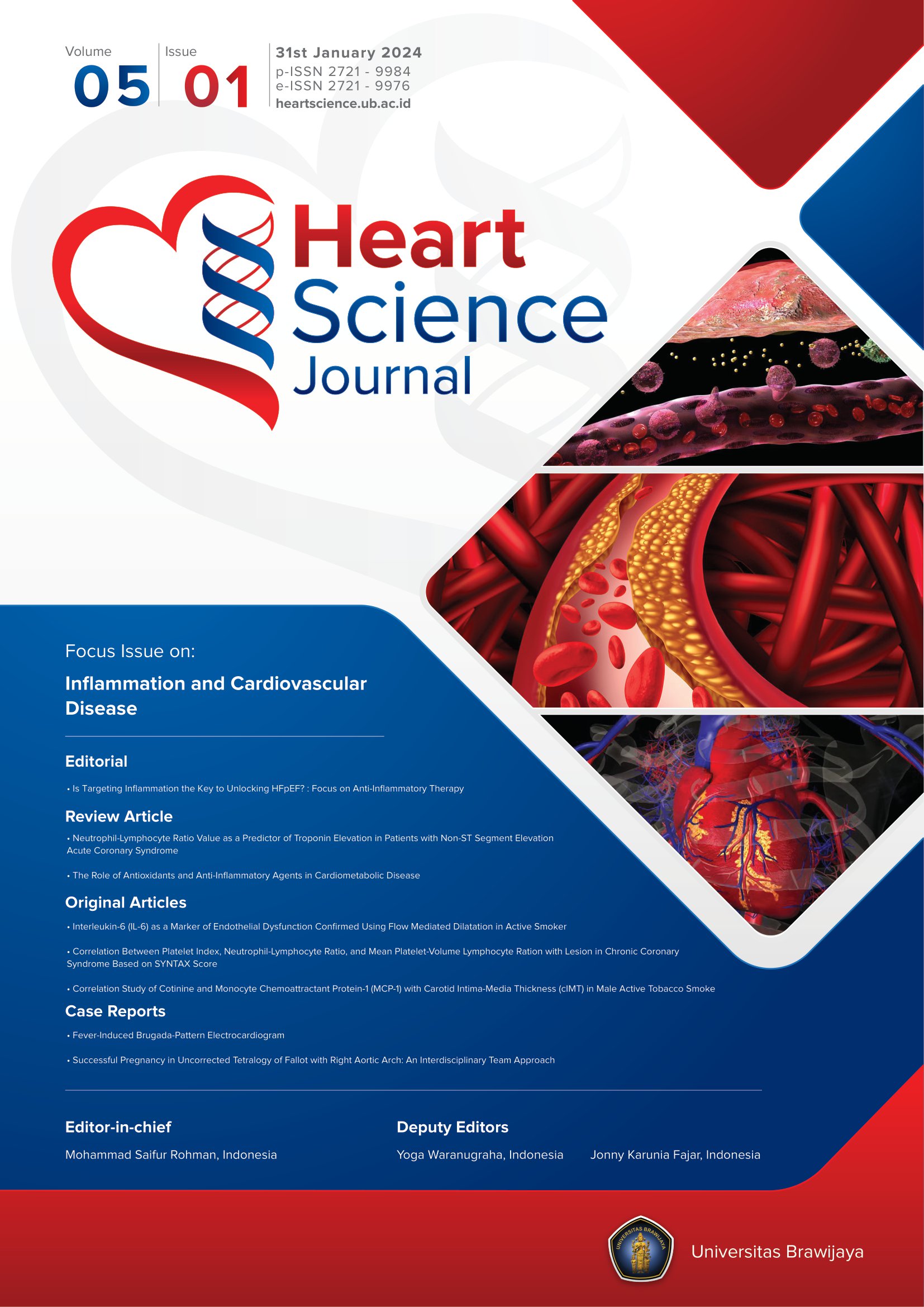Quantitative Assessment of Chronotropic Incompetence Using Time Domain Heart Rate Variability Derived from 24 – Hours Ambulatory Holter Monitoring
Abstract
Background : Chronotropic incompetence (CI) is defined as the failure of the heart to increase its heart rate along with activity and is an independent predictor of cardiovascular morbidity and mortality. The gold standard for CI is based on a treadmill test. However, up to now, there is no guideline to recommend whether CI could be concluded according to holter monitoring data.
Objective : This study aimed to determine CI based on Holter monitoring, specifically using time-domain analysis of heart rate variability (HRV).
Methods : This study used descriptive-analytic research with cross-sectional sampling. The population was patients that underwent treadmill and holter monitoring. The treadmill test was used as a gold standard of CI, and compare to holter monitoring using heart rate variability as a parameter. Data analysis used a comparative study (Independent T, Mann-Whitney, Chi-Square) and multivariate analysis logistic regression with a significance of p < 0,05.
Results: The subjects of the study were 111 patients with male-dominant (59 men). Standard Deviation N-N interval (SDNN) and Standard Deviation of Average N-N Interval (SDANN) were found lower in the CI group compared to the normal one. Mean SDNN was 113,57 + 51,08 msec in CI group and 117,4 + 39,48 msec in normal group with p = 0.282. Mean SDANN was 94,77 (73,42-118,85) in CI and 104,16 (74,9–139) with p = 0.422. While the Proportion of RR interval with the difference > 50 ms (RR50) and Average of All N-N Intervals (AVNN) found to be higher in CI group, but not statistically significant (p = 0.681; p = 0.061 respectively). Other parameter extracted from holter result, delta HR showed significant correlation with CI (50.5 (43,25-61,5) vs. 56 (50-72) with p = 0.014).
Conclusion: Time-domain HRV didn’t had a significant correlation with CI. However, delta HR from holter monitor could be used as a predictor of CI.
Keywords
Full Text:
PDFReferences
Brubaker Peter H., Kitzman Dalane W. Chronotropic Incompetence. Circulation. 2011 Mar 8;123(9):1010–20.
Katritsis D, Camm AJ. Chronotropic incompetence: a proposal for definition and diagnosis. Br Heart J. 1993 Nov;70(5):400–2.
Astrand I. Aerobic work capacity in men and women with special reference to age. Acta Physiol Scand Suppl. 1960;49(169):1–92.
Lauer MS, Okin PM, Larson MG, Evans JC, Levy D. Impaired heart rate response to graded exercise. Prognostic implications of chronotropic incompetence in the Framingham Heart Study. Circulation. 1996 Apr 15;93(8):1520–6.
Efficacy and Safety of Exercise Training in Patients With Chronic Heart Failure: HF-ACTION Randomized Controlled Trial [Internet]. [cited 2020 May 31]. Available from: https://www.ncbi.nlm.nih.gov/pmc/articles/PMC2916661/
Zweerink Alwin, van der Lingen Anne-Lotte C.J., Handoko M. Louis, van Rossum Albert C., Allaart Cornelis P. Chronotropic Incompetence in Chronic Heart Failure. Circ Heart Fail. 2018 Aug 1;11(8):e004969.
Li H, Li J, Zhou X, Zhao J, Zhang F, Wu L, et al. Clinical feasibility of a new method to identify chronotropic incompetence in heart failure patients. Physiol Meas. 2016;37(11):1968–80.
Temporal Reduction in Chronotropic Index Predicts Risk of Cardiovascular Death Among Healthy Middle‐Aged Men: a 28‐Year Follow‐Up Study | Journal of the American Heart Association [Internet]. [cited 2020 Jun 8]. Available from: https://www.ahajournals.org/doi/10.1161/JAHA.116.004555
Azarbal B, Hayes S, Arbit B, Friedman J, Thomson L, Berman D. Relationship Between Diabetes Mellitus and Chronotropic Incompetence in Prediction of All-Cause Mortality. J Am Coll Cardiol. 2013 Mar 12;61(10 Supplement):E1115.
Verrotti A, Prezioso G, Scattoni R, Chiarelli F. Autonomic Neuropathy in Diabetes Mellitus. Front Endocrinol [Internet]. 2014 Dec 1 [cited 2020 May 31];5. Available from: https://www.ncbi.nlm.nih.gov/pmc/articles/PMC4249492/
Balcıoğlu AS, Müderrisoğlu H. Diabetes and cardiac autonomic neuropathy: Clinical manifestations, cardiovascular consequences, diagnosis and treatment. World J Diabetes. 2015 Feb 15;6(1):80–91.
Brubaker PH, Kitzman DW. Prevalence and management of chronotropic incompetence in heart failure. Curr Cardiol Rep. 2007 May;9(3):229–35.
Witte KKA, Cleland JGF, Clark AL. Chronic heart failure, chronotropic incompetence, and the effects of β blockade. Heart. 2006 Apr 1;92(4):481–6.
Zweerink A, van der Lingen A-L, Handoko M, Rossum A, Allaart C. Chronotropic Incompetence in Chronic Heart Failure: A State-of-the-Art Review. Circ Heart Fail. 2018 Aug 1;11.
Al-Najjar Y, Witte KK, Clark AL. Chronotropic incompetence and survival in chronic heart failure. Int J Cardiol. 2012 May 17;157(1):48–52.
Jorde UP, Vittorio TJ, Kasper ME, Arezzi E, Colombo PC, Goldsmith RL, et al. Chronotropic incompetence, beta-blockers, and functional capacity in advanced congestive heart failure: Time to pace? Eur J Heart Fail. 2008;10(1):96–101.
Nugraha AW, Tjahjono CT, Rizal A. Increasing Age, Diabetes Mellitus and Beta Blocker Influence Heart Rate Recovery Values in Patients Undergoing Exercise Treadmill Test. ACI Acta Cardiol Indones. 2019 Mar 27;5(1):35–43.
Khan MN, Pothier CE, Lauer MS. Chronotropic Incompetence as a Predictor of Death Among Patients With Normal Electrograms Taking Beta Blockers (Metoprolol or Atenolol). Am J Cardiol. 2005 Nov 1;96(9):1328–33.
Hirsh B, Mignatti A, Garan A, Uriel N, Colombo P, Sims D, et al. Effect of -Blocker Cessation on Chronotropic Incompetence and Exercise Tolerance in Patients With Advanced Heart Failure. Circ Heart Fail. 2012 Aug 1;5:560–5.
Kawasaki T, Kaimoto S, Sakatani T, Miki S, Kamitani T, Kuribayashi T, et al. Chronotropic incompetence and autonomic dysfunction in patients without structural heart disease. Eur Eur Pacing Arrhythm Card Electrophysiol J Work Groups Card Pacing Arrhythm Card Cell Electrophysiol Eur Soc Cardiol. 2010 Apr;12(4):561–6.
Borchini R, Veronesi G, Bonzini M, Gianfagna F, Dashi O, Ferrario MM. Heart Rate Variability Frequency Domain Alterations among Healthy Nurses Exposed to Prolonged Work Stress. Int J Environ Res Public Health [Internet]. 2018 Jan [cited 2020 Jun 1];15(1). Available from: https://www.ncbi.nlm.nih.gov/pmc/articles/PMC5800212/
Heart rate variability. Eur Heart J. 1996;17:28.
DOI: https://doi.org/10.21776/ub.hsj.2020.001.02.4
Refbacks
- There are currently no refbacks.
Copyright (c) 2020 Ardian Rizal

This work is licensed under a Creative Commons Attribution 4.0 International License.









